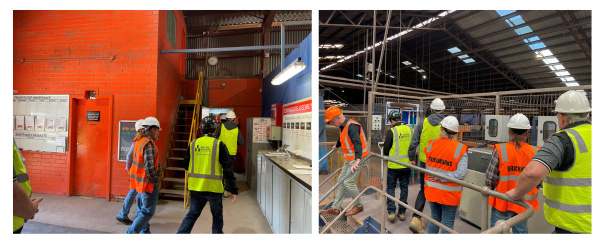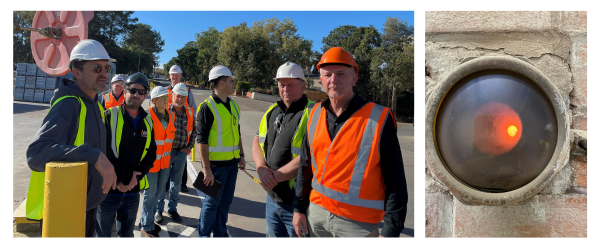JAMES HARDIE SITE TOUR AUSTRAL BRICK SITE TOUR GUIDELINES FOR REG. POOLS ENERGY ASSESSMENTS & SOFTWARE
James Hardie Site Tour
The James Hardie manufacturing facility tour consisted of a technical talk by Dan Hanara (James Hardie - Install & Construction Manager) together with a walk through of the manufacturing process and facility.
The technical discussions covered upcoming new products for improved durability and performance along with a technical deep dive into installation specifications for individual products. The discussion included an open forum for IBC members to ask questions and relay concerns the industry is currently experiencing.
With the industry challenges around condensation management, the James Hardie Team discussed their innovative cavity system to manage air movement and moisture vapour. The onsite prototypes of various cladding configurations provided different ways of installing James Hardie cladding systems to mitigate condensation problems.
One of the systems was a new pre-finished brushed concrete cladding which is an alternative to the traditional blue board and render finish. The advantages of the new system is the wide tongue and groove finish which prevents cracking of the finished walling system and minimise maintenance and repair due to differential movement on sites.
Energy Efficiency was a hot topic of conversation and what specific product systems will assist. With industry concerns on how to achieve the new 7 Star rating, it was an excellent opportunity to visually see what wall and flooring options are available. The Hardies team advised their Architectural range has the versality to assist in achieving the required 7 Star rating together with their pliable building membrane, cavity system to address condensation.
The plant tour walkthrough and technical talks throughout the morning, proved to be a great benefit for our IBC members. Key knowledge was gained around product installation and how the Hardie’s selection can have a major contribution to industry problems.
Austral Brick Site Tour
The tour to Austral Brickworks manufacturing site and design studio included a walk-through the manufacturing operation line at Rochedale followed by a visit to the design studio at James Street Newstead.
Steve Winward -Qld Sales Manager conducted the tour of the facility. The group learnt the history of Austral Bricks which was formed back in 1908 and how the bricks are made. The interesting fact is Austral Bricks are the largest brick manufacturer in Australia (listed ASX). The Australian company has been manufacturing and designing bricks for over 100 years and today has a group of companies under the Brickworks banner across Bricks, Pavers, Masonry, Stone, Roofing and building industry supplies for the installation of brickwork. Learning the history and process behind the scenes was a valuable experience for the IBC attendees.
The technical walk through provided an opportunity to visually see the stages of manufacturing a brick from extrusion, cutting, colouring, drying stages, the kiln process, product packing and distribution. A total of 80 million bricks a year are produced through the Rochedale factory.

The environmental wastage strategies being implemented throughout the factory included recycling of materials and gas. Austral Bricks is currently recycling the spoil from the Cross River Rail project which will amount to 60,000 cubic metres, or 100,000 tonnes of spoil. The next few years one in every two homes that are built in Southeast Queensland will have a piece of the Austral history.
The Brickworks design studio is exceptional and a great way to see the finished products. These included the coloured glass brick series and the new mechanical cladding system (thin brick) utilising an engineered channel where the bricks are clicked into place and mortar installed to the bed and perpend joints.
A PowerPoint presentation included the recently completed building (Riviere) at Kangaroo Point where the Brickworks team were a part of the design team in the collaboration phase to assist in problem solving and providing customised detailing for the front façade.
This involved an innovative custom breeze block construction to act as a barrier system between the spandrels for fall protection and still provide cross ventilation through the unit complexes when the windows are open.

Updated guidelines for regulated pools
If you are doing pool safety inspections, you need to know that as of 1 June the following guidelines for swimming pools were updated:
- Guideline for pool safety inspectors
- Guideline for pool owners and property agents
- Local government swimming pool safety guideline.
The updates include:
- restructuring the guidelines so information is grouped in a logical, consistent manner across all three guidelines
- removing historical information about the development of current pool safety laws as these laws have been in place for over 10 years
- removing the reference to the advisory function of pool safety inspectors as this is not reflected in the legislation
- adding an explanation of what a ‘regulated pool’ is clarifying and correcting information regarding:
- the role of pool safety inspectors
- the role of local government in supporting regulated pool safety, including the requirement to inspect pools, the types of inspections they may conduct, and their role in cancelling a pool safety certificate
- the role of building certifiers in assessing compliance with the pool safety standard
- the role of property agents in attending to pool safety matters on behalf of property
- owners
- the difference between the regulated pools register and the pool safety inspectors
- register
- the inspection process, including when a pool owner may change pool safety inspectors, and what happens when a nonconformity notice, or pool safety certificate, is issued the use of temporary fencing
- dividing fences, including the rights and responsibilities of owners, how to apportion
- costs, and how to address disputes
- minor repairs, maintenance and non-climbable zone works, and other work on a pool barrier
- the sale and lease compliance system for non-shared pools.
Energy assessments for new residential dwellings and use of accredited software
Queensland adopted the Energy Efficiency changes as of 1 May 2024. The Government provided advice for building certifiers, other building practitioners and homeowners about energy assessments in Queensland for new residential dwellings when accredited software is used to demonstrate compliance with the energy efficiency standards.
Additionally, the Queensland Development Code (QDC) 4.1 Sustainable Buildings was updated to provide new variations for energy efficiency. This variation allows a one-star credit to be used in all climate zones in Queensland. You can also choose to use the 2019 deemed to satisfy elemental tables if not wanting to go down the software pathway.





